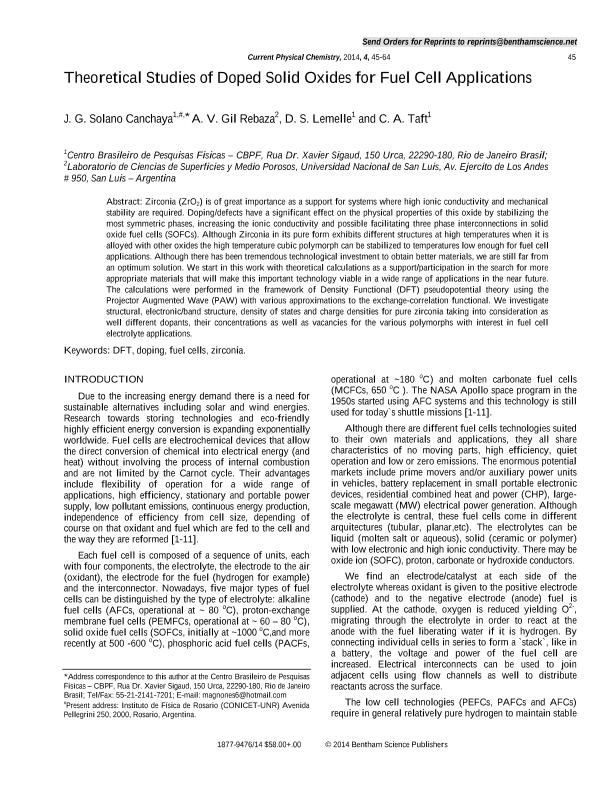Mostrar el registro sencillo del ítem
dc.contributor.author
Solano Canchaya, José Gabriel

dc.contributor.author
Gil Rebaza, Arles Víctor

dc.contributor.author
Lemelle, D. S.
dc.contributor.author
Taft, C. A.
dc.date.available
2017-09-06T22:41:12Z
dc.date.issued
2014-02
dc.identifier.citation
Solano Canchaya, José Gabriel; Gil Rebaza, Arles Víctor; Lemelle, D. S.; Taft, C. A.; Theoretical studies of doped solid oxides for fuel cell applications; Bentham Science Publishers; Current Physical Chemistry; 4; 1; 2-2014; 45-64
dc.identifier.issn
1877-9468
dc.identifier.uri
http://hdl.handle.net/11336/23738
dc.description.abstract
Zirconia (ZrO2) is of great importance as a support for systems where high ionic conductivity and mechanical stability are required. Doping/defects have a significant effect on the physical properties of this oxide by stabilizing the most symmetric phases, increasing the ionic conductivity and possible facilitating three phase interconnections in solid oxide fuel cells (SOFCs). Although Zirconia in its pure form exhibits different structures at high temperatures when it is alloyed with other oxides the high temperature cubic polymorph can be stabilized to temperatures low enough for fuel cell applications. Although there has been tremendous technological investment to obtain better materials, we are still far from an optimum solution. We start in this work with theoretical calculations as a support/participation in the search for more appropriate materials that will make this important technology viable in a wide range of applications in the near future. The calculations were performed in the framework of Density Functional (DFT) pseudopotential theory using the Projector Augmented Wave (PAW) with various approximations to the exchange-correlation functional. We investigate structural, electronic/band structure, density of states and charge densities for pure zirconia taking into consideration as well different dopants, their concentrations as well as vacancies for the various polymorphs with interest in fuel cell electrolyte applications.
dc.format
application/pdf
dc.language.iso
eng
dc.publisher
Bentham Science Publishers

dc.rights
info:eu-repo/semantics/openAccess
dc.rights.uri
https://creativecommons.org/licenses/by-nc-sa/2.5/ar/
dc.subject
Dft
dc.subject
Doping
dc.subject
Fuel Cells
dc.subject
Zirconia
dc.subject.classification
Otras Ciencias Físicas

dc.subject.classification
Ciencias Físicas

dc.subject.classification
CIENCIAS NATURALES Y EXACTAS

dc.title
Theoretical studies of doped solid oxides for fuel cell applications
dc.type
info:eu-repo/semantics/article
dc.type
info:ar-repo/semantics/artículo
dc.type
info:eu-repo/semantics/publishedVersion
dc.date.updated
2017-09-06T19:28:00Z
dc.identifier.eissn
1877-9476
dc.journal.volume
4
dc.journal.number
1
dc.journal.pagination
45-64
dc.journal.pais
Emiratos Árabes Unidos

dc.journal.ciudad
Sharjah
dc.description.fil
Fil: Solano Canchaya, José Gabriel. Centro Brasileiro de Pesquisas Físicas; Brasil. Consejo Nacional de Investigaciones Científicas y Técnicas; Argentina
dc.description.fil
Fil: Gil Rebaza, Arles Víctor. Universidad Nacional de San Luis. Laboratorio de Ciencias de Superficies y Medios Porosos; Argentina. Consejo Nacional de Investigaciones Científicas y Técnicas; Argentina
dc.description.fil
Fil: Lemelle, D. S.. Centro Brasileiro de Pesquisas Físicas; Brasil
dc.description.fil
Fil: Taft, C. A.. Centro Brasileiro de Pesquisas Físicas; Brasil
dc.journal.title
Current Physical Chemistry
dc.relation.alternativeid
info:eu-repo/semantics/altIdentifier/url/http://www.eurekaselect.com/117247/article
dc.relation.alternativeid
info:eu-repo/semantics/altIdentifier/doi/http://dx.doi.org/10.2174/18779468113036660022
Archivos asociados
